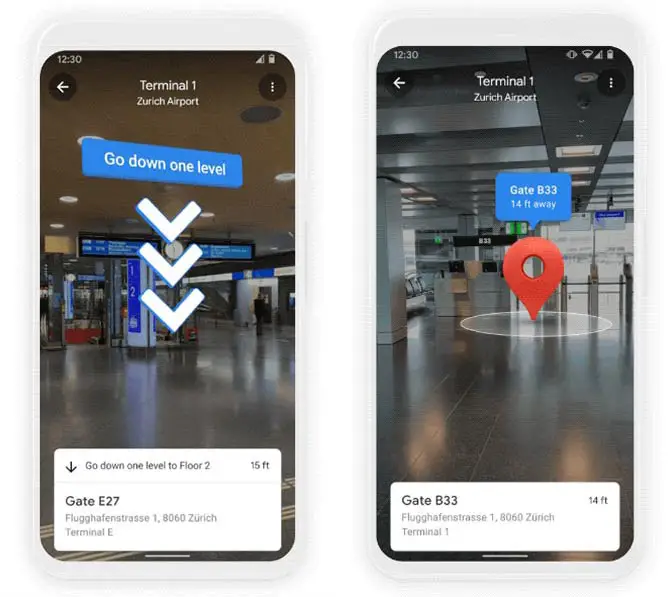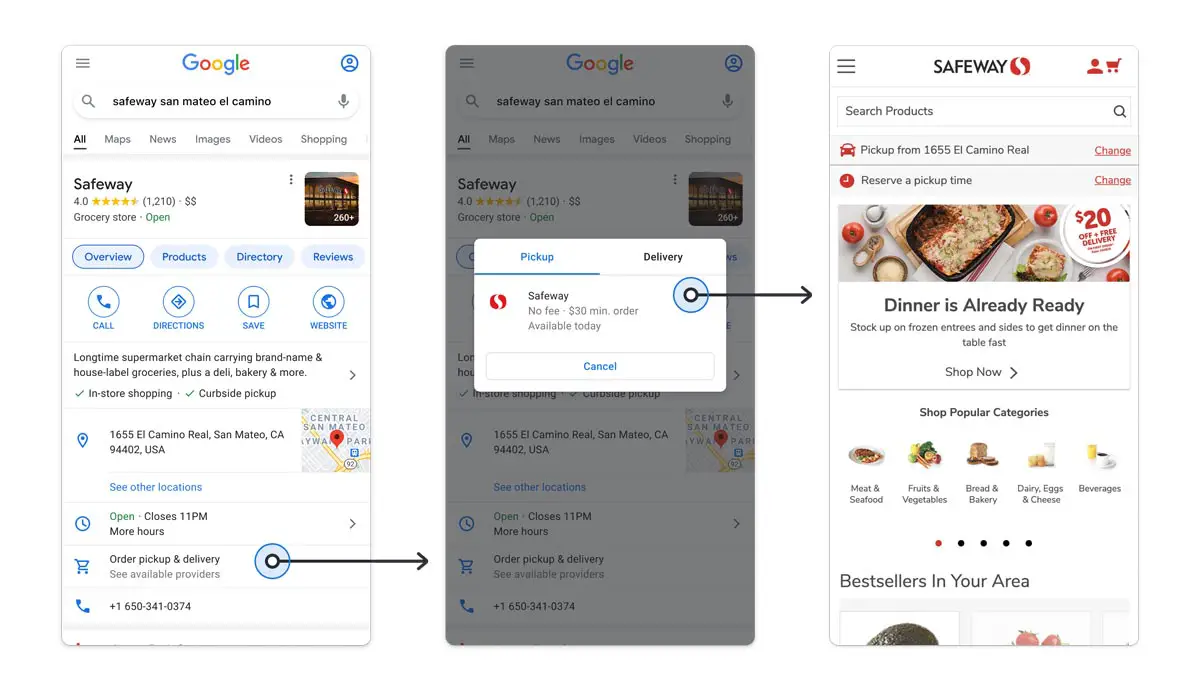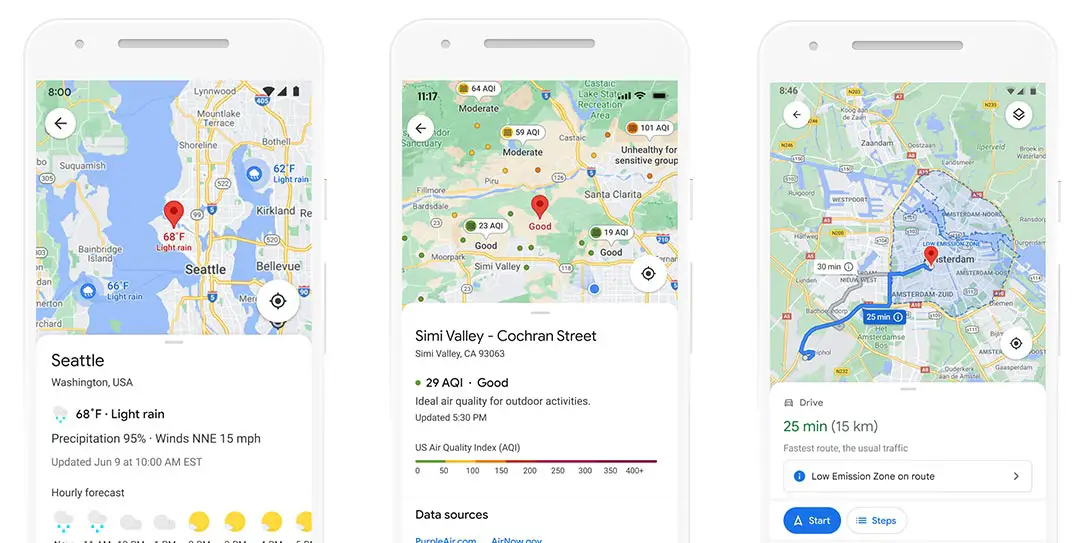Google Maps is the go-to source for map and direction information for millions of users worldwide since its launch 16 years ago. Constantly updated, Google Maps is receiving several new layers, Live View indoor navigation, eco-friendly direction options, and curbside grocery pickup.
Estimated reading time: 5 minutes
The new features are powered by AI, giving users “the most accurate, up-to-date information about the world, exactly when you need it.” Most of the features will be rolling out to the U.S. and select regions throughout this year.
A quick overview of the new features coming to Google Maps include:
- Indoor Live View: Using AR and Street View imagery, you’ll be able to navigate airports, train stations, and malls.
- New Weather and Air Quality Layers: See current and forecasted weather conditions, along with air quality wherever AQI stations are available.
- Eco-friendly routes in driving navigation: Thanks to a new routing model, Google Maps will automatically default to the route with the lowest carbon emissions footprint if it has roughly the same ETA. If the eco-friendly route increases your ETA significantly, you can choose between the fastest route or the one that’s more eco-friendly.
- Low emission zone alerts: Get an alert when you’ll be driving through a low emission zone so you can quickly know if your car is allowed in the area, select another mode of transportation, or take another route.
- New directions experience: We’re making it easier to choose sustainable transportation options – compare all routes and modes of transportation to a destination – including cycling, transit and walking options – without toggling between tabs. Maps will also boost routes and modes you’re likely to be interested in.
- Pickup and delivery actions: See important details about service provider options, pickup and delivery windows, fees and order minimums right from Search and Maps for select grocery retailers.
- Pickup with Google Maps Pilot: In partnership with The Kroger Co. (an American grocery retail company), we’re piloting an easier way to pick up your groceries curbside.
- Assistant Driving Mode Expansion: Use voice to send and receive calls and texts, quickly review new messages across multiple messaging apps in one place, get a read-out of texts, and more — all without leaving the navigation screen. Expanding to new languages and 13 new countries around the world.
Live View
While Live View has been around for awhile, it is only enabled while you’re outdoors. Using AI, Google is now able to bring Live View to indoor locations including malls, airports, and transit stations. This feature can help travellers find exits, elevators, ATMs, washrooms, and more. The new features is now live on Android and iOS at various malls in Chicago, Long Island, Los Angeles, Newark, San Francisco, San Jose, and Seattle. It will be coming to select transit stations, airports, and malls in Zurich and Tokyo in the coming months.
Weather and Air Quality Layers
Layers are another key feature of Google Maps, allowing users to toggle information that is important to them. Google can tell you what the weather is going to be like, and now users globally can toggle a new weather layer to see what the current and forecasted weather along their route is. Rolling out globally, the weather date is pulled from The Weather Company.
Data from AirNow.gov and the Central Pollution Board will be used in Australia, India, and the U.S. to power the new air quality layer. Toggling this layer will show users how healthy, or unhealthy, the air quality is in their area or along their route. This layer is planned for release in more countries at later dates.
Eco-friendly Routes
When hitting Google Maps to find directions from point A to point B, users can already choose a number of ways to get around. These include driving, bus, cycling, or walking depending on where you are. Google has built a new routing model using insights from the U.S. Department of Energy. This model “optimizes for lower fuel consumption based on factors like road incline and traffic congestion.”
Google will take these factors into consideration when showing you the best route to your destination, and if two routes have a similar ETA, Google will automatically show you the more eco-friendly option. If the eco-friendly option adds a significant amount of time, both routes will be shown with the relative CO2 impact. Users can also adjust their preferences in Google Maps’ settings to always choose the fastest route. This feature will rollout initially in the U.S. with global launch coming at a later date.
Other features are coming as well, including marking low emission zones (launching this June in Germany, the Netherlands, France, Spain, and the UK), a new comprehensive view of different transportation modes to your destination, and ranking your preferred modes like biking or the subway where applicable.
Curbside Grocery Pickup
With the pandemic, delivery and curbside pickup from retail and groceries to everything in between has seen a huge increase. Starting in the U.S., businesses can add pickup and delivery windows, fees, and order minimums to their Business Profiles on Google Maps and Search. This feature will start with Instacart and Albertsons Cos. stores initially. This summer will see a pilot program with select Fred Meyer supermarkets in Portland, Oregon. Under this program, you can add your order for pickup on Google Maps after checking out from the store’s app, and Google will send you a notification when it’s time to leave and allow you to share your arrival time with the store. If you are delayed on the way, your ETA will be updated with the store, with the goal being to have your pickup brought out as soon as you arrive and not before or after.
What do you think about the new layers and features coming to Google Maps? Will you be using the new weather and air quality layers or eco-friendly routing? Let us know in the comments below or on Twitter, Facebook, or MeWe.












